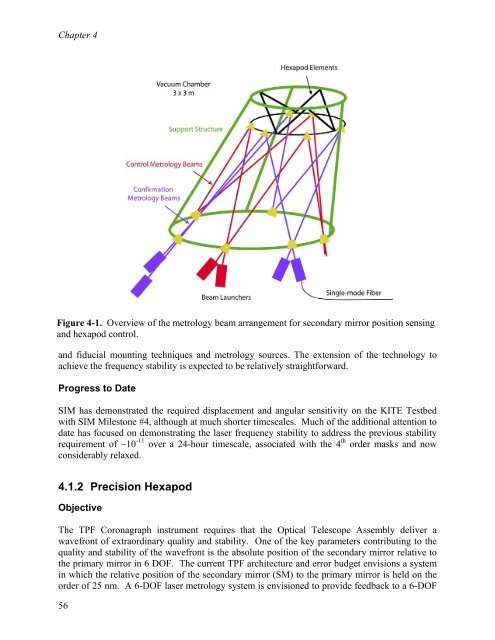TPF-C Technology Plan - Exoplanet Exploration Program - NASA
TPF-C Technology Plan - Exoplanet Exploration Program - NASA
TPF-C Technology Plan - Exoplanet Exploration Program - NASA
You also want an ePaper? Increase the reach of your titles
YUMPU automatically turns print PDFs into web optimized ePapers that Google loves.
Chapter 4<br />
Figure 4-1. Overview of the metrology beam arrangement for secondary mirror position sensing<br />
and hexapod control.<br />
and fiducial mounting techniques and metrology sources. The extension of the technology to<br />
achieve the frequency stability is expected to be relatively straightforward.<br />
Progress to Date<br />
SIM has demonstrated the required displacement and angular sensitivity on the KITE Testbed<br />
with SIM Milestone #4, although at much shorter timescales. Much of the additional attention to<br />
date has focused on demonstrating the laser frequency stability to address the previous stability<br />
requirement of ~10 -11 over a 24-hour timescale, associated with the 4 th order masks and now<br />
considerably relaxed.<br />
4.1.2 Precision Hexapod<br />
Objective<br />
The <strong>TPF</strong> Coronagraph instrument requires that the Optical Telescope Assembly deliver a<br />
wavefront of extraordinary quality and stability. One of the key parameters contributing to the<br />
quality and stability of the wavefront is the absolute position of the secondary mirror relative to<br />
the primary mirror in 6 DOF. The current <strong>TPF</strong> architecture and error budget envisions a system<br />
in which the relative position of the secondary mirror (SM) to the primary mirror is held on the<br />
order of 25 nm. A 6-DOF laser metrology system is envisioned to provide feedback to a 6-DOF<br />
56
















